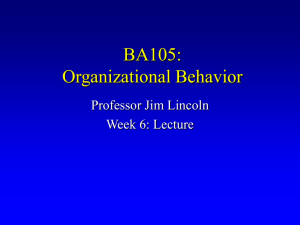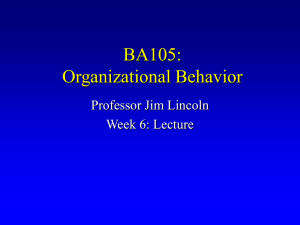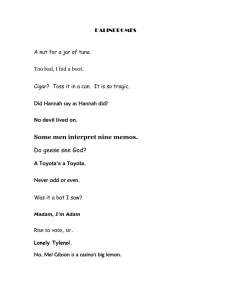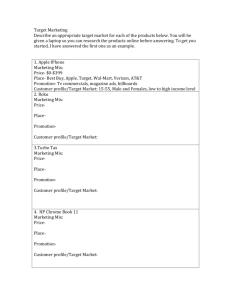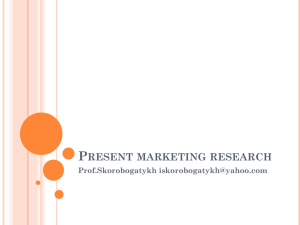CLASSICAL ADMINISTRATIVE THEORY
advertisement
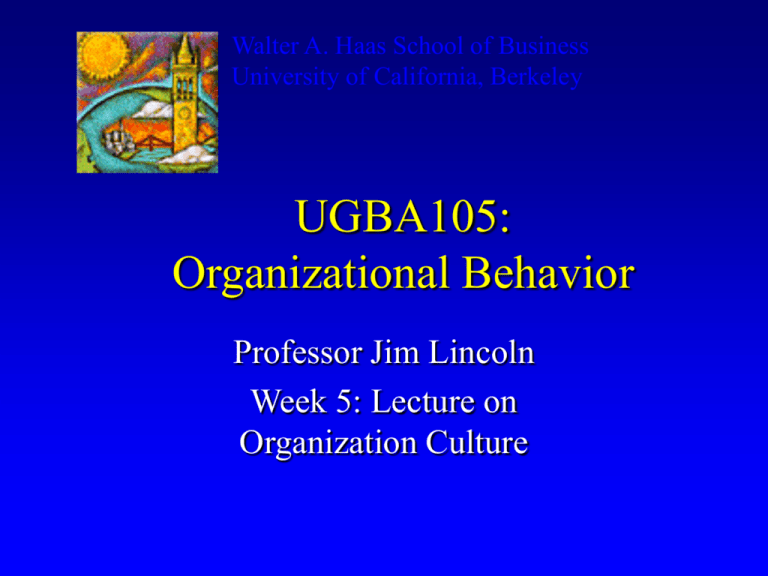
Walter A. Haas School of Business University of California, Berkeley UGBA105: Organizational Behavior Professor Jim Lincoln Week 5: Lecture on Organization Culture • Last time: Leadership vision and charisma as levers for change • This week: Analyzing and managing organizational culture 2 Class business: Tuesday agenda Mary Kay video Body Shop case – What is the culture of the Body Shop and where did it come from? – How (and how effectively) did TBS manage its culture? – Was the Body Shop’s penchant for modelling itself on the opposite of standard cosmetic industry practice a matter of core values or smart business strategy? – Is the story of the Body Shop chiefly one of culture or one of leadership? Next Thursday: Review for Exam: Come with questions! 3 Congruence Model Informal Organization Input Output Environment Resources Strategy Formal Organization Tasks Systems Unit History Individual People 4 The nature of culture Fuzzy, ephemeral, intuitive • “No one can define the HP way. If it weren’t fuzzy, it would be a rule” (HP Vice President) – Emotional, charismatic, spiritual • Takes “emotional intelligence” to navigate – Holistic and enveloping 5 The Berkeley Way “It's invisible but omnipresent. Most know it exists but few can actually define it. Newcomers are perplexed by it. Confronting it head on can be dangerous.” “The name of this nebulous creature? It's known on campus as "The Berkeley Way" -- an unwritten code of conduct that governs how people go about their business.” The Berkeleyan, February 16, 2000 6 Where did the concept of culture come from? The critique of 1950’s corporate culture: overconformity and alienation – William H. Whyte’s The Organization Man (Doubleday, 1956) – The Man in the Gray Flannel Suit (20th Century Fox, 1956) 7 The new view of culture as an organizational asset Discovery of Japanese management in 80’s – William Ouchi: Theory Z (1981) – Tom Peters and Robert Waterman: In Search of Excellence (1979) – Richard Pascale and Anthony Athos: The Art of Japanese Management (1983) – Ezra Vogel: Japan as No. 1 (1985) – James Abegglen and George Stalk: Kaisha (1985) 8 What is culture? • Shared values, norms, beliefs/understandings – Values define what is important – Norms define appropriate attitudes and behaviors – Beliefs define reality • Manifested in: – Ritual, ceremony, tradition, language – Folklore, heroes, legends, stories, songs • Transmitted through: – Informal networks – Logos, slogans, PR, advertising, annual reports, websites 9 The behavioral norms at P&G Juelene Beck, who worked as P&G beverage brand assistant from 1984 to 1986, says supervisors once questioned whether a trendy haircut and suit were "appropriate" for P&G. During performance reviews, she says, she was asked why she preferred sailing to socializing with co-workers. 10 How culture is manifested & channeled: Heroes 11 Ceremonies 12 Contests, sports, recreational activities 13 Office parties 14 Logos and symbols 15 Language and jargon • Southwest – People Department – Culture Committee • Executive ranks at Chumbo Corp. – Grand Pooh-Bah – Web Goddess – Director of Something 16 Core values Is making $ a value? The culture paradox: – An organization whose core values transcend making money will make the most money “Profits are to a corporation much like breathing is to life. Breathing is not the goal of life, but without breath, life ends. Similarly, without turning a profit, a corporation, too, will cease to exist.” Dennis Bakke, CEO, AES Corporation 17 Examples of core values: Southwest Airlines Value 1: Work should be fun…it can be play…enjoy it Value 2: Work is important…don’t spoil it with seriousness Value 3: People are important…each one makes a difference. It used to be a business conundrum: “Who comes first? The employees, customers, or shareholders?” That’s never been an issue to me. The employees come first. If they’re happy, satisfied, dedicated, and energetic, they’ll take real good care of the customers. When the customers are happy, they come back. And that make the shareholders happy.” Herb Kelleher 18 Saturn: “Putting people first” “Saturn was created with one simple idea: to put people first. (Its) mission (is) to create a different kind of car company — one dedicated to finding new ways for people to work together to design, build and sell cars” Saturn website 19 “Respect the divine and respect people” “Our goal is to strive toward both the material and spiritual fulfillment of all employees… and through this … fulfillment, serve mankind in its progress and prosperity. We are scientists directing our efforts toward perfecting technology. But we must not forget that complete process of living requires devotion to humanity as well as to science, to the emotional as with the rational, and to love equally with reason. Just as a family unites in a common bond of support and affection, let us all unite in a bond of love and respect.” Do spirituality and emotionality have a place American management? 20 More core values • Customer service (IBM, Nordstrom) • Innovation, creativity (3M, Intel, HP) • Competitiveness, aggressiveness (GE, Motorola, Pepsi) • Social responsibility (Ben and Jerry’s; BP?) Levi’s; The Body Shop; Mary Kay Cosmetics, Working Assets) • Quality (Toyota; Ford?) 21 Strong and weak cultures – Strong: Consistent, persistent, intense, shared, crystallized, consensual, consequential – Weak: Vague, fragmented, inconsistent, transitory, politicized, conflictual 22 Strong culture companies as cults, tribes, and churches “What do the Branch Davidians and Microsoft have in common? Give up? Both organizations are cults. In both, the members are cut off from the real world and are obsessed with achieving the mission of their leaders. For the Davidians, it was the charismatic David Koresh; for Microsoft, it's the world's richest man, Bill Gates. Corporate Cults: The Insidious Lure of the All-Consuming Organization by David Arnott (NY: AMACOM, 2000). 23 Apple as tribe “Apple is a lot like a tribe, with folklore handed down from generation to generation. The question is how can we channel it? We are trying to shift away from folk heroes and individualism in the organization, but we have selected people for this in the past, and we don’t punish that kind of behavior. --Apple executive 24 The church of "IBM, more than any other big company, has institutionalized its beliefs the way a church does. They are expounded in numerous IBM internal publications to ensure that employees know what's expected of them. And they are reflected in codes of behavior…(S)alespersons wear dark business suits and white shirts. ....the result is a company filled with ardent believers.. The IBM culture is so pervasive that, as one nine-year former employee put it, “leaving the company is like emigrating." 25 Dimensions of culture strength Sharing Intensity Complacent “country club” culture Strong, organizationwide culture Absence of culture (anomie) Subcultures 26 Subcultures • Around departments, occupations, divisions, demographics • Source of in-group cohesion, out-group competition, conflict, and politics • Is the overall organization culture strong enough to subsume subcultures? 27 28 What does strong culture do? • • • • 29 General Manager Engineering Manufacturing Marketing Product A Culture 30 How does it help the bottom line? • Lower cost – Fewer formal control systems • Better quality/productivity/customer service • Culture as branding “Ben and Jerry’s unconventional, anti-big-business values ..emerged as the company’s biggest brand asset” Workforce Management, April 26, 2005 • Culture as sustainable competitive advantage – Hard-to-imitate capabilities • "The ExxonMobil culture is something that a lot of people would like to understand better. I'm not really going to help them understand it, because it's the source of our competitive advantage.“ Exxon Mobil CEO Rex Tillerson as quoted by CNNMoney, 4/3, 2006 31 What are the downsides to strong culture? • • • 32 SAS Institute “Some call James Goodnight’s SAS Institute “the Stepford software company” after the movie The Stepford Wives. In the movie people were almost robotlike in their behavior, apparently under the control of some outside force. The place can come across as being a bit too perfect, as if working there might mean surrendering some of your personality.” O’Reilly and Pfeffer: Hidden Value. 33 Strong culture breeds homogeneity at P&G Few corporate cultures are as dominant as the "Procter Way." "It's such a strong culture, they really want sameness," says Ms. Beck, who later worked as a brand manager for Dunkin Donuts and as a vice president for Burger King. "The way women think and the way we do business has some inherently different qualities to it," Ms. Beck says. "In retrospect, there was a gender aspect to [P&G's culture] that was not intentional, but was very, very real.“ WSJ, 9/9/98 34 “…at one point product features became the religion, not the vision. This drove prices up and closed out individuals (as customers). --Apple executive 35 Enron’s “culture of corruption” or the absence of culture? The management’s aims.. were to minimise taxes, maximise apparent profits and, in some cases, to line their own pockets. The directors' report was described by Senator Byron Dorgan, who is leading another investigation into the company’s collapse, as “devastating”, adding that “this is almost a culture of corporate corruption.” --The Economist, 2/12/02 36 Managing & changing culture: Step I: Study it • Be culturally savvy (vs. clueless): pay attention • Do a culture audit: – Find key informants • oral histories with tribal elders • map genealogies • learn folklore – Be a “fly on the wall” • Ethnography & participant observation – Study texts • Annual reports, websites, advertising – Do value surveys 37 Step II: understand its causes • Leader/founder – Family ownership (Ford) • Long history – Railroads, P&G (founded 1837), Levi Strauss (founded 1873) • Society – Asia/Europe • Region – Northern California/Manhattan/South – Small town vs. big city • Amana, Cummins, Corning, Chase, Citibank • Product – Apple, Coke • Industry – High tech/petroleum/investment banking • Structure – Functional/divisional/process 38 “Wal-Mart is Ozark culture writ large” Wal-Mart's culture is a "macrocosm" of the brutal hillcountry society now exported to the world. Early WalMart management was not that far removed from being Ozark farmers themselves. They treated the women and other employees the way they treated their own wives and others under their influence. New York Review of Books, April 28, 2005 39 Where do Honda and Toyota’s cultures come from? Honda executives say Toyota..will have difficulty emulating Honda's unique culture. "All Toyota is doing is aping us and letting their money talk," says Ken Hashimoto, a senior Honda R&D executive. (But) Toyota, in spite of its often-ridiculed "country boy" image, has been proving that it can successfully woo young car buyers, thanks to designers such as Takao Minai. Mr. Minai languished for a long time in Toyota's hierarchical culture but had a sudden leap in responsibilities two years ago. (T)he ponytailed 36-year-old amateur video jockey took charge of developing a dream car for male twentysomethings. Wall Street Journal 9/21, 2000 40 Apple’s product-driven culture “Here’s the most interesting thing about our culture-- we are what we make. I’ve never seen an organization where the personality of the organization is so intertwined with the personality of the product--individualistic, pure, uncompromised, ahead of everyone else, so elegant it can’t fail. We are the Macintosh here.” Apple Marketing Manager 41 Step III: Align/realign the organization – Find visionary, charismatic, committed leadership – Change people – Change the formal organization • Structure • Measurement and incentive systems – Change the informal organization • Build cohesive networks • Stop politics 42 Aligning people • Selection and socialization (buy or make) • First, selection: – Select for fit or “misfit” to the culture • Intensive screening 43 Selection at Microsoft In 1999, the average age of the more than 31,000 Microsoft employees was only 34, and raw intelligence matters more than judgment or experience in determining who gets hired. Craig Mundie, senior vice president for consumer strategy, described Microsoft "as a company full of a lot of high IQ people who have relatively no experience." 44 Selection at Apple Sculley came to a company renowned for its exciting and countercultural work environment, where employees often wore T-shirts that proclaimed “working 90 hours a week and loving it.” Sculley described Apple as “the Ellis Island of American business because it intentionally attracted the dissidents who wouldn’t fit into corporate America.” Harvard Business School Press 45 Selecting for “bad fit” at HP (Wall Street Journal interview with former CEO Lew Platt) WSJ: Did you feel constrained running a company that had legendary founders and a culture enshrined in a book? Platt: A little bit. There were certain constraints. There were certain traditions they wanted upheld. WSJ: Give me an example. Platt: They were very conservative -- heavy investment in R&D, little debt. I was asked not to question those things. WSJ: Ms. Fiorina is a woman, a nonengineer and an outsider -- all firsts for H-P. What should we read into that? Platt: They wanted someone who could bring change, someone with a higher visibility. Most H-P people are pretty low-key. David [Packard] and Bill [Hewlett] were that way. I'm that way. Carly comes in without some of those constraints. She will question some of the thinking that I, as a 33-year employee, couldn't. 46 Aligning people • Socialization – – – – – Focus on firm-specific values and tacit skills Invest heavily in training, including OJT Mentoring Participation Rites of passage • “Humiliating-inducing experiences” 47 Selection and socialization at P&G Job candidates must pass a battery of tests measuring aptitude and leadership skills. Once hired, employees are schooled in all things Procter, even attending training seminars known as P&G College. 48 Hell Camp: Extreme resocialization “Founded nine years ago in the foothills of Mt. Fuji, Hell Camp claims to have subjected some 100,000 Japanese salarymen to 13 days of speed drills, speechifying and hazing rituals. Its main message-- “100 liters of sweat; 100 liters of tears” was designed to counteract a growing fear among Japan’s corporate and government elite that the nation’s workers are becoming too “Americanized”, too soft. The school’s solution, for nearly $3000 a pop: to crush the individual ego with mindless and humiliating exercises and then rebuild it with a modern version of the Samurai code of selfless servitude called bushido.” “Japanese-style camp for managers is lost in translation in U. S.: Hazing rituals and obeisance don’t make it in Malibu even among freeloaders. WSJ, March 1, 1988. 49 (Re)Align the formal organization – Structure • From divisional to functional (HP) • From functional to divisional (Ford) – Systems • Accounting/information • Compensation 50 Carly Fiorina’s failed effort to change HP’s culture with a re-org She launched a plan to consolidate H-P's 83 businesses into only 12. Executives fretted that managers wouldn't wield "real" authority if they couldn't control both product development and marketing. "It took .. the glory.. out of the job," says Mr. Perez, the departed executive. Consternation rippled through the ranks. Managers who had long aspired to run their own autonomous units, known as P&Ls, short for profit & loss, suddenly saw most of those jobs disappear. 51 CEO Jacques Nasser’s failed effort to change Ford’s culture with a re-org Since the hard-charging 51-year-old executive took over in January (1999) Nasser has declared war on Ford's stodgy, overly analytic culture. In its place, he envisions a company in which executives run independent units--cut loose from a stifling bureaucracy and held far more accountable for success and failure. 52 Aligning rewards at Cisco “Chambers is adamant about rewards being tied to customer satisfaction. He ties the compensation of all managers to measures of customer satisfaction– really listening to the customer. “We are the only company of anywhere near this size that does it.” O’Reilly and Pfeffer: Hidden Value 53 Culture takeaways • Culture is an extremely powerful force in every organization – It can lead to either success or to failure • Culture may be “soft” but it can be managed and changed – It does take time, commitment, and consistency 54
